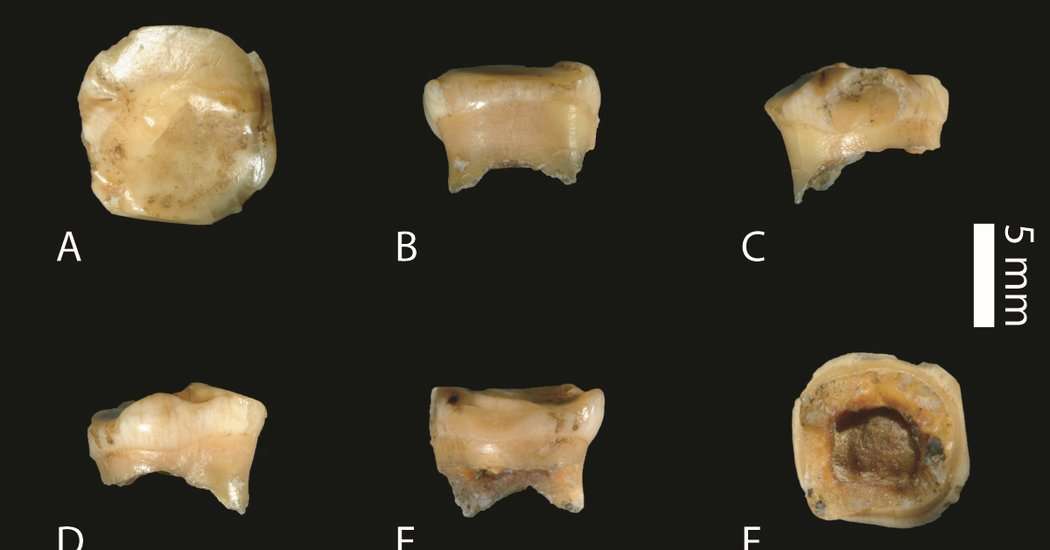“We think based on the DNA sequences that ‘Denisova 2’ is at least 100,000 years, possibly 150,000 years old. Or a bit more,” said Ms. Slon. “So far it makes it the oldest Denisovan.”
Advertisement Continue reading the main story
She said the baby tooth is at least 20,000 years older than the next oldest Denisovan specimen, a molar labeled ‘Denisova 8.’ It is also one of the oldest hominin remains found in Central Asia so far.
To determine the origins of ‘Denisova 2’ the team first performed a CT scan of the tooth to preserve its structure for future studies. Then Ms. Slon donned a pair of gloves and used a dentistry tool to scrape off the tooth’s surface in order to reduce contamination lingering from the cave site or where it was stored. Using a different drill bit, she drilled into its root and collected about 10 milligrams of material, which contained DNA.
After sequencing the DNA she compared genetic information from the sample with genetic data already collected from Denisovans, Neanderthals and modern humans.
“We saw it was most similar to Denisovan mitochondrial genomes,” she said. “That was exciting because that was a good indication that this was another Denisovan individual.”
Bence Viola, a paleoanthropologist from the University of Toronto and an author on the paper, said there was not too much to be learned from studying the tooth’s morphology or appearance.
The genetic analysis, on the other hand, provided the keys to learning more about the species. He said the genetic study was something the team most likely could not have done five years ago without destroying the tooth.
“For a long time we didn’t want to work on it because it’s such a small specimen,” he said.
But by drilling into the tooth and performing the genetic analysis the scientists were able to not only figure out who it belonged to, but also provide relative dates for when the Denisovan lived. The study also suggests that the species had less genetic variability than modern humans, but more genetic diversity than seen in Neanderthal nuclear DNA.
Todd R. Disotell, a molecular anthropologist from New York University who was not involved in the study, said that the team’s genetic analysis was “rock solid.” He said that what he found most interesting was how old the sample was, which showed how long Denisovans lived around the cave, and the insight it provided to the species’ genetic variation.
Newsletter Sign Up Continue reading the main story Please verify you're not a robot by clicking the box. Invalid email address. Please re-enter. You must select a newsletter to subscribe to. Sign Up You agree to receive occasional updates and special offers for The New York Times's products and services. Thank you for subscribing. An error has occurred. Please try again later. View all New York Times newsletters.
“This is four people in one cave and they have more variation than is in the Neanderthals, which are spread over 10,000 kilometers and over several hundreds of thousands of years.”
He added that the findings help show the diversity of humanlike species that once inhabited Earth at the same time.
Dr. Bernard A. Wood, a professor of human origins at the Center for the Advanced Study of Human Paleobiology at George Washington University, said the paper demonstrated the power of molecular biology as a tool for paleoanthropology.
“Talk about extracting blood from a stone,” he said, “this is extracting treasure from a tooth.”

nombre1 on July 8th, 2017 at 07:12 UTC »
I thought DNA broke down far to rapidly for a sample this old to be usable. I guess 100k years is a bit different than the Jurassic era, but I'm still crushed that the park will never be real.
pumpkinandpeach on July 8th, 2017 at 05:16 UTC »
Can someone explain this in a broad context?
Mictlantecuhtli on July 8th, 2017 at 00:32 UTC »
Direct link to article - http://advances.sciencemag.org/content/3/7/e1700186